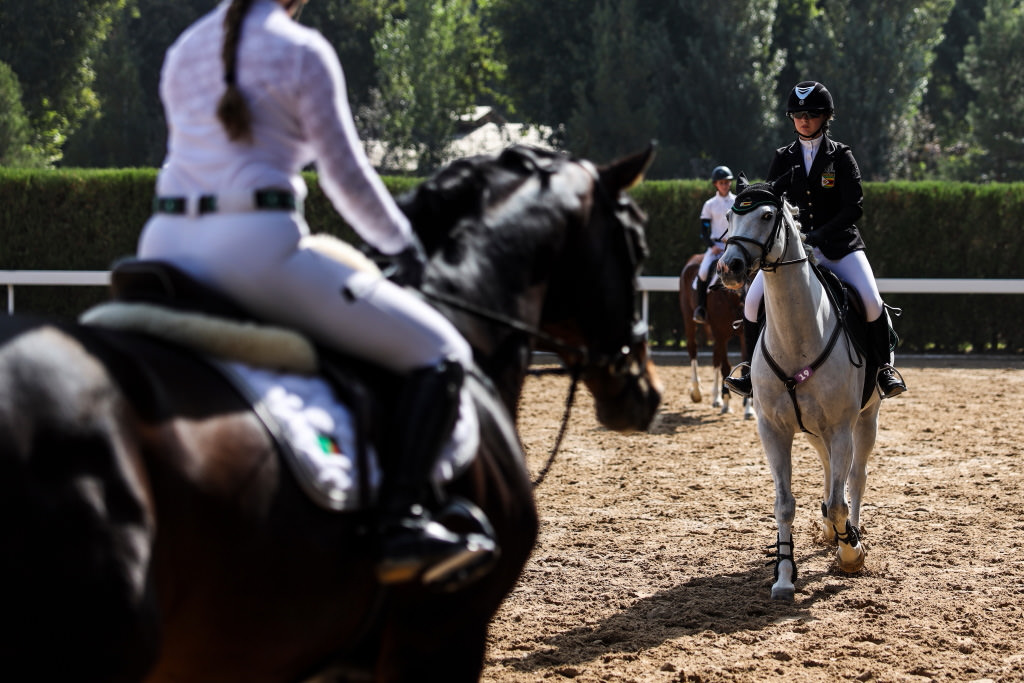EOS R: Capturing Compelling Moments in Equestrian Photography
Every picture-worthy moment is an encounter between the photographer and his subjects. They last a few seconds at most, and won't happen the same way ever again. If you want to capture these moments, you need more than just a photographer's discerning eye. Photojournalist and sports photographer Yong Teck Lim took the EOS R to the FEI (Fédération Equestre Internationale) World Jumping Challenge Final in Tashkent, Uzbekistan. He provides a glimpse into the world of equestrian sports beyond the thrill and action. (Photos by: Yong Teck Lim)

EOS R/ RF28-70mm f/2L USM/ FL: 31mm/ Manual exposure (f/16, 1/800 sec)/ ISO 2000/ WB: Auto
A moment of “pure luck”, where timing, composition and settings all fell together nicely—no doubt with some help from the EOS R’s fast, responsive AF.
The two sides of equestrian sports
Many people see only one side of equestrian sports.
This side has all the action. Horses galloping around an arena, kicking up sand and dust in their wake, or perhaps soaring over high fences in a show-jumping event.
But beneath it all, under the ups and down of shows, victories and defeats, lies a layer that is lesser-known to outsiders but no less compelling. It involves the strong connection between a rider and his/her horse. You can see this in tender moments of bonding where a rider closes her eyes and presses her cheek to her horse’s nose, or where the horse nuzzles and snuggles up to its rider.
To Yong Teck, it is this side of equestrian sports that makes it different from other sports. It is also what he likes most about photographing it.
However, regardless of whether it is the action that interests you or the quieter, more emotional moments, it is always possible to capture compelling images that tell a story.

EOS R/ RF28-70mm f/2L USM/ FL: 41mm/ Manual exposure (f/2.2, 1/4000 sec)/ ISO 100/ WB: Auto
In equestrian photography, you usually have two subjects—horse and human. Both have to look good, but this can be challenging especially when both the horse and rider are moving. For scenes like this where you have to capture two fast-moving subjects in sharp detail, AF tracking is very important. Yong Teck was impressed by the EOS R’s solid AF tracking performance, which was good enough to help him achieve shots like this one.
Even quiet interactions can be over before you know it
Over time, you learn what works and what does not. Yong Teck shares that in the three years since his first equestrian photography assignment in 2015, he has become more familiar with horses and their behaviour, which in turn has helped him to take better shots. Things like, “Make sure the ears of the horse are up—it shows that the horse is happy”. The angles that work, and those that don’t.
But the ears still move fast, and horses, while calm and majestic, don’t necessarily stay still!

EOS R/ RF28-70mm f/2L USM/ FL: 28mm/ Manual exposure (f/2, 1/400 sec)/ ISO 6400/ WB: Auto
A candid moment between a rider and her horse, captured in a dark stable. Despite the dim lighting conditions, the EOS R’s Face Detection was spot-on, and the AF established focus quickly. Noise in the dark areas is barely visible even at ISO 6400, testament to the EOS R’s excellent low light performance.

EOS R/ RF28-70mm f/2L USM/ FL: 58mm/ Manual exposure (f/2, 1/2500 sec)/ ISO 100/ WB: Auto
Another chance encounter in the yard. The entire world seems to stop and revolve around the two, perhaps thanks to the beautiful bokeh in the background. For this particular competition, riders had to ride “borrowed horses”, in other words, horses that they were unfamiliar with. It’s hard to tell from the close connection that horse and human seem to share in these images.
What it takes to capture fleeting moments
Picture-perfect moments last a few seconds at the most—miss them, and they are gone forever. The stakes get higher when, like Yong Teck’s, your shooting style involves seeking and capturing unexpected moments that are not planned or posed. That gut feeling that tells you that a particular chance encounter—that slice in time—would make for a compelling image. When that gut feeling hits, you have to react fast and move fast.
And not only that, your camera has to respond fast.

EOS R/ RF28-70mm f/2L USM/ FL: 70mm/ Manual exposure (f/2.2, 1/2500 sec)/ ISO 100/ WB: Auto
A passing encounter in the field. That instance where all the elements in an image fall into place lasts only a split second. When you release the shutter matters, and so does your camera's reaction speed and how quickly it can achieve focus.
Indeed, it was in this aspect that Yong Teck found the EOS R most impressive, even “comparable to the EOS 5D Mark IV and EOS 1D-X Mark II”, the latter of which he usually shoots with.
With the EOS R’s expanded AF coverage area and high-speed Dual Pixel CMOS AF system, which claims to be capable of acquiring focus in as fast as 0.05 seconds*, you don’t expect anything less.
* with the RF24-105mm f/4L USM
Click here to find out more about the EOS R
Receive the latest update on photography news, tips and tricks.
Be part of the SNAPSHOT Community.
Sign Up Now!About the Author
A photographer and editor specialising in sports, Yong Teck’s journey in sports photography began in college, where he covered school sports for a local sporting news site. After graduating with a Bachelor of Arts in Communication, he worked as a multimedia producer with Reuters before venturing into freelance sports photography, where his work has been used in major global publications such as Sports Illustrated, ESPN, the New York Times, the Los Angeles Times, the Washington Post, and the Guardian. He is currently a photo editor with Getty Images.



































